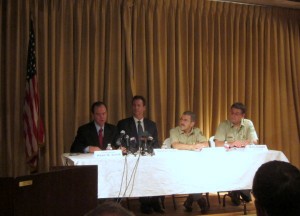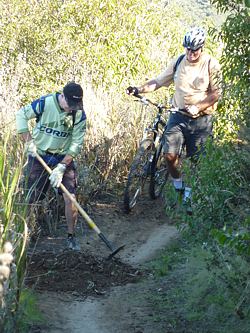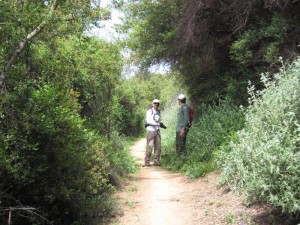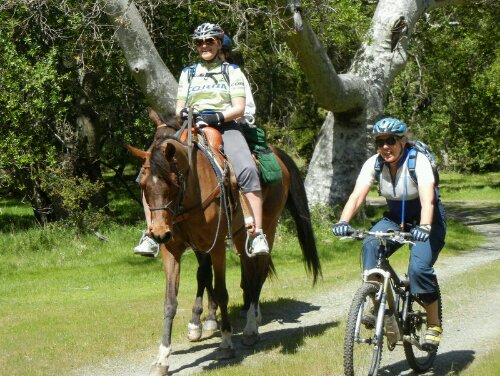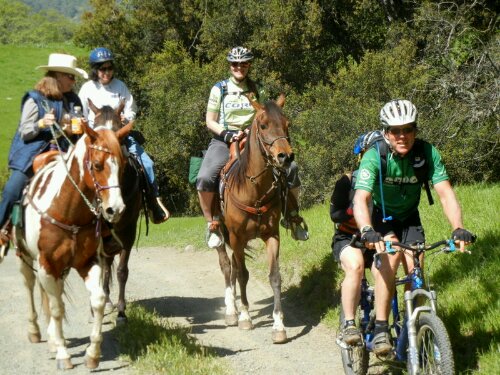Today, April 28, 2011, Congressman Adam Schiff (D-CA) hosted a panel discussion on the ongoing investigation into the Station Fire being conducted by the Government Accountability Office (GAO). The room at Altadena Public Library was filled to capacity with standing room only, with several TV cameras and members of the Media there to cover the event.
CORBA’s Steve Messer was also in attendance, looking for answers to unresolved questions about how the fire was managed. Messer was in the forest the day the Station Fire began, scheduled to do trailwork on the Sam Merrill trail with CORBA’s volunteer trail crew.
On the panel were Congressman Schiff, Stephen Gaty from the GAO’s Natural Resources and Environment team, Tom Harbour, director of Fire and Aviation for the USFS, and Deputy Superintendent of the Angeles National Forest, Marty Dumpis.
After Congressman Schiff gave a brief outline of the process and a summary of people’s concerns about the fire, each of the panel members gave opening remarks outlining where they are in the ongoing evaluation, and what we can look forward to. We learned from Gaty that the investigation is expected to continue until the end of the year, at which time the full report will be published on the GAO’s web site. The objectives of the investigation are to determine: how the Forest Service responded to the fire, whether or not they followed established procedures, the key questions their response to the fire raised, and what they can learn from the incident moving forward.
Tom Harbour gave a rundown of how things have changed, and how the FS has prepared for the upcoming fire season. According to Harbour, the FS has renewed and strengthened its communications and agreements with the L.A. County fire department, and that they will be prepared. We were assured that it will be easier for the FS to summon assets from L.A. County in the event of another fire.
There are 80 rotor-wing aircraft and 18 tankers in the FS fleet, he said, though he didn’t make it clear that this is for the USFS nationwide. It is an aging fleet including WWII era craft, which they don’t want to “wear out” by double-shifting. Many were dismayed at this revelation. He assured people that life and property are the FS first priority, while on the other hand seeming to indicate that the wearing out of an aging fleet takes precedence in the management of assets.
Harbour also reiterated that the FS continues to evaluate the addition of night-flying capability to their fire fighting assets, something that could have quelled the fire on its first day. The evaluation is expected to take a further two months. Cost is the biggest issue at this time. Audience members raised the question of whether a 25 million investment in additional aircraft could be weighed against the cost of damage and recovery efforts. According to Gaty, that would be beyond the scope of the GAO investigation.
Many in the audience were not impressed by what they were hearing. One Big Tujunga canyon resident asked about the FS policy regarding structures on leased land within the forest, vs. the policy regarding structures on private land within the forest. He turned and asked the gathered crowd how many had lost homes in the fire. More than a dozen hands went up. Mr. Harbour was placed on the spot several times in succession as members of the audience questioned a policy that left their homes undefended.
The biggest criticisms laid against the FS by Schiff and echoed by many in the audience, was the length of time this investigation is taking to complete. La Canada-Flintridge council member Laura Olhasso rebuked the FS for drawing out this process for so long, and urged them to speed up this process. The audience applauded her comments.
More Forest Openings Expected
Of particular interest to many is the length of time the forest has remained closed. Marty Dumpis publicly announced that approximately 98,000 acres of the 180,000 acres in the current closure are expected to open by memorial day weekend. That will include about 110 miles of re-opened trails. The openings will mostly occur in the northern, eastern and western borders of the current closure. Trails may not be in the best shape, he said, but many FS personnel have expressed frustration at their inability to enforce the closure. An open forest is easier to manage than a closed one.
Dumpis made no mention of the Angeles Front Country. We will continue to work with the Forest Service to help survey and restore trails in the closure area. Dumpis also added that the Big Tujunga Canyon area will likely remain closed for at least another year, as they monitor the recovery of endangered species and sensitive plant species.
Through a grant from the Air Quality Management District, they have begun re-planting about 11,000 acres of forest, mostly in the high country. 4,000 of those acres will be completed this year.
Public Input Requested
Gaty extended an invitation to anyone with information that may be relevant to the investigation to contact his office. Though he couldn’t confirm that every question would be answered by the investigation, he felt it important to gather as many of those questions and observations as people had.
Though the session was important, many left dissatisfied with what they learned, or rather, didn’t learn today. We thank Congressman Schiff for continuing to move this investigation forward, and for involving the public in the process.


